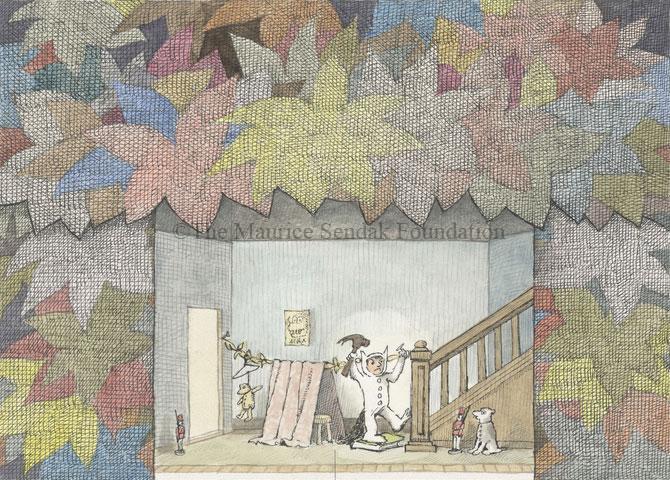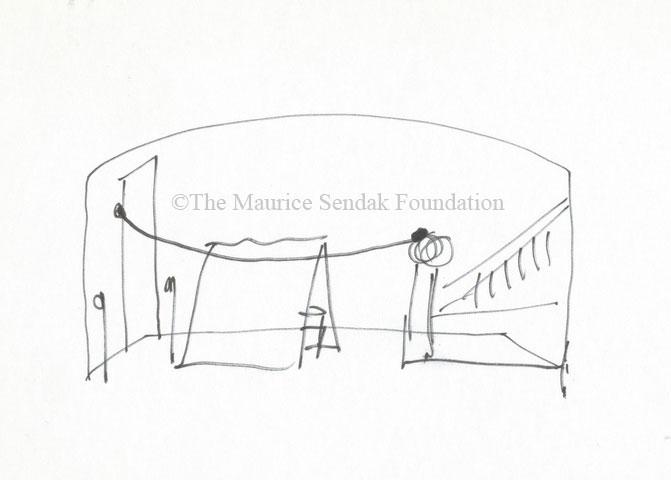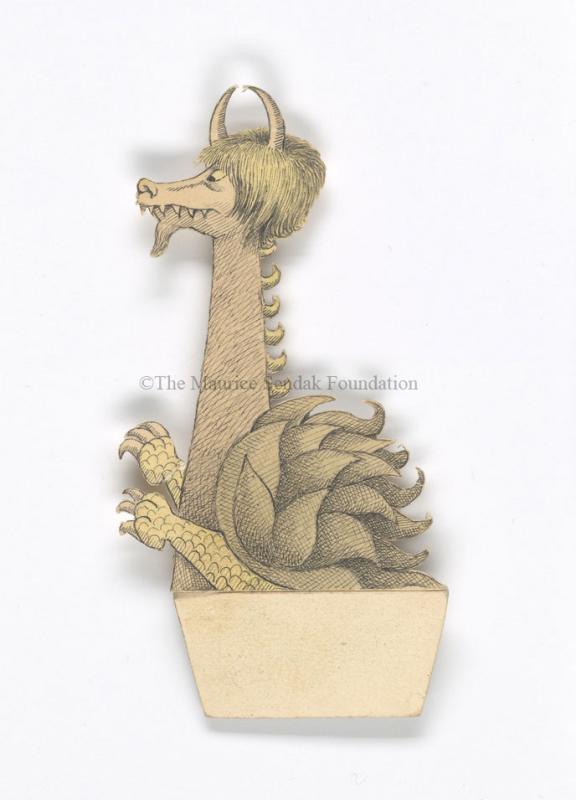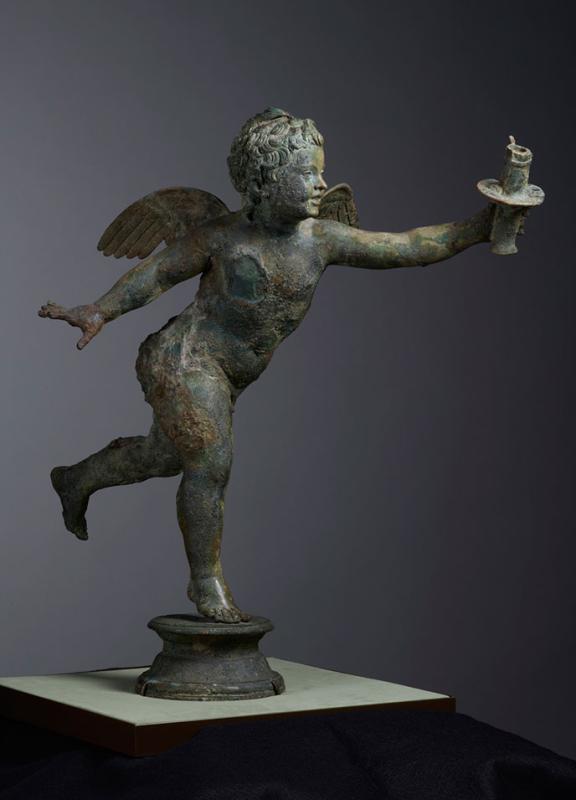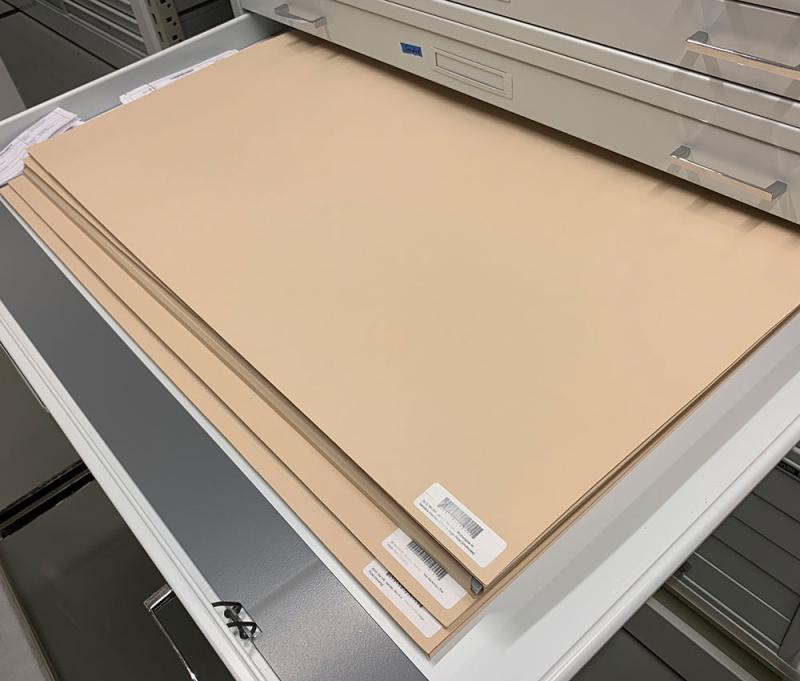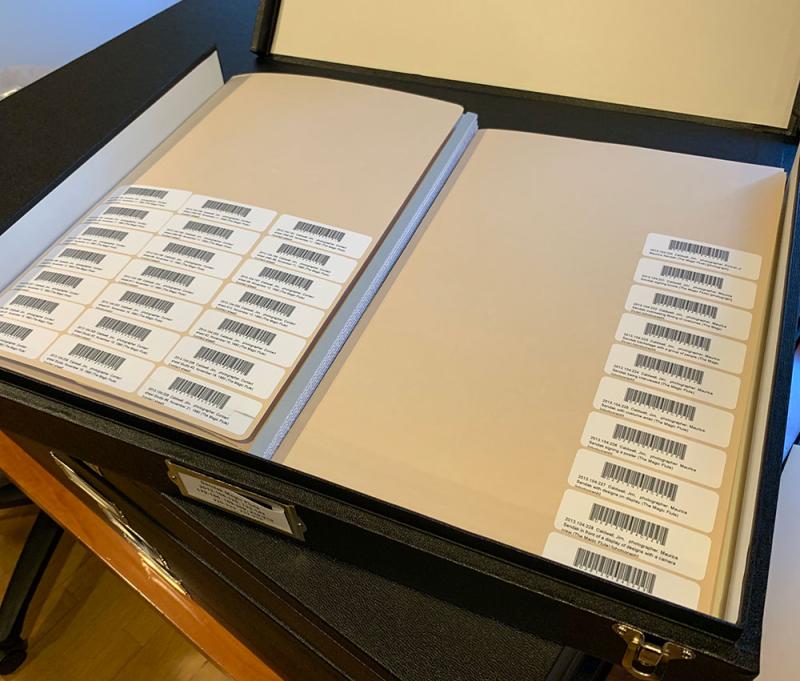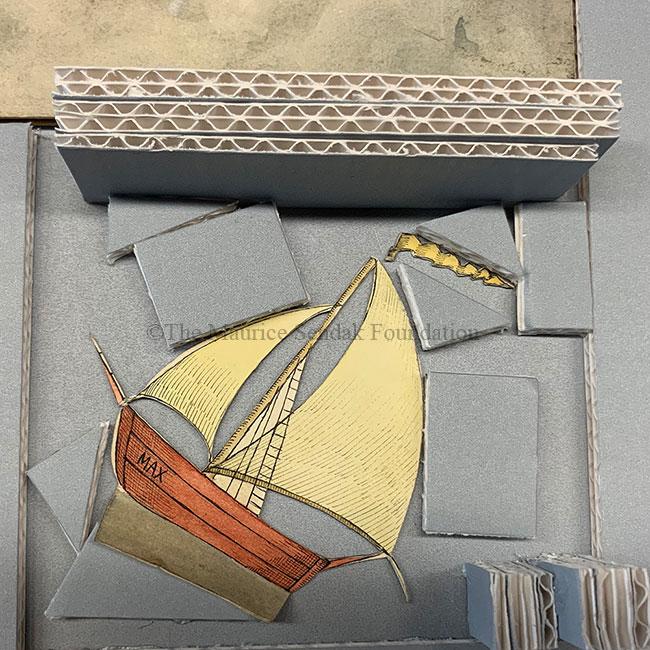This post was created by Michael Caines, Conservation Assistant, and Lindsey Tyne, Associate Paper Conservator
Over 900 objects relating to Maurice Sendak’s (1928–2012) stage designs for The Magic Flute, The Cunning Little Vixen, Love for Three Oranges, The Nutcracker, and an opera based on Where the Wild Things Are arrived at the Morgan in 2013 as part of the artist’s extraordinary bequest. For many of us, the magic of Sendak’s books, in particular Where the Wild Things Are, live vividly in the memories of our childhood. It is thus both a delight and an honor to create a safe home for these wonderful objects.
The objects in the bequest are varied in materials and formats, including drawings in ink, graphite, and watercolor; hand-drawn models of set flats, props, and figures that, when combined together, create fantastical stage-set dioramas; small sheets containing notes and sketches; textile samples; commercial posters; and documentary photographs and prints. Given the overall good condition of the objects, the primary concern became how to integrate them into our existing storage system. Each object in the bequest, like all objects in the Morgan’s collection, needs a housing enclosure to mitigate potential damage. And, since the Morgan functions as an active museum and research institution, the enclosures we create need to offer easy access for staff and researchers.
In conversation with the Modern & Contemporary Drawings department, we concluded that it was important to organize the Sendak objects by production, and within that scheme, we would group like objects together to make the most efficient use of space. To begin we asked a simple question: Is the object flat or three-dimensional? For this project, we defined a flat object as anything made up of a sheet of paper. This includes all the drawings, sketches, notes, photographs, prints, and posters (figures 1, 2).
Anything bulkier than a single sheet of paper we defined as a three-dimensional object. Almost all of these objects are associated with the stage-set dioramas. In this diorama of Max’s sea journey from Where the Wild Things Are (figure 3), there are nine separate objects. Three of these are the left and right panels of the flower proscenium (figure 4) and the figure of the Sea Monster (figure 5). These objects, like all of those that make up Sendak’s dioramas, consist of a drawing in ink, watercolor, and/or graphite on paper that is adhered to a piece of thick paperboard for rigidity. The edges of the paperboard are hand cut to the contours of the drawing. Objects like these may not seem three-dimensional in comparison to, for example, the bronze Running Eros, Holding a Torch (AZ010, figure 6) on view in the Librarian’s Office of J. Pierpont Morgan’s Library, but in terms of this project, they definitely need different enclosures and will take up more storage volume than the flat objects.
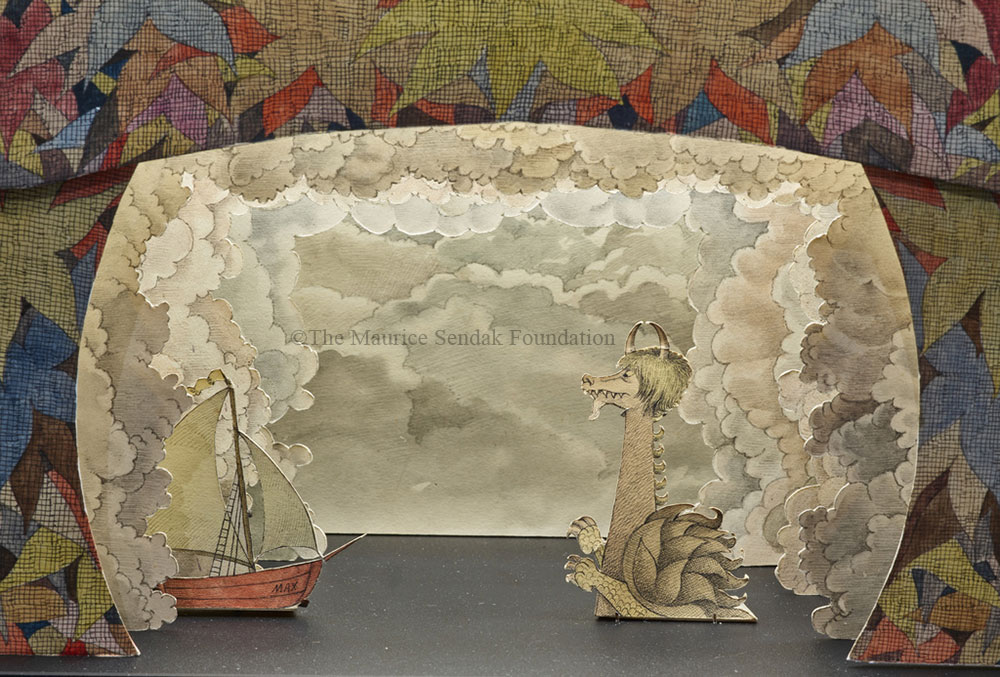
[Figure 3]
Diorama of Max's sea journey (Where the Wild Things Are) as installed in Drawing the Curtain: Maurice Sendak’s Designs for Opera and Ballet, 2019. The Morgan Library & Museum, Bequest of Maurice Sendak, 2013. Reproductions of flower proscenium models (2013.103:69a-b and 2013.103:70), 2013.103:58e, 2013.103:60, 2013.103:61, 2013.103:62, 2013.103:63, and 2013.103:73. Artwork ©The Maurice Sendak Foundation. Digital Image ©The Morgan Library & Museum.
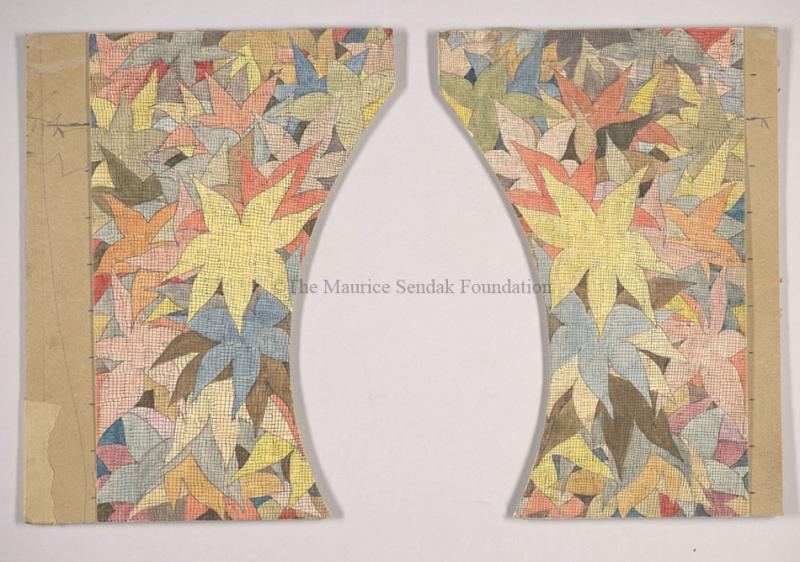
[Figure 4]
Maurice Sendak, Flower proscenium models (Where the Wild Things Are), 1979–1983. Watercolor, pen and ink, and graphite pencil on paper mounted to paperboard, 8 1/4 x 6 3/16 inches and 8 1/4 x 5 11/16 inches. The Morgan Library & Museum, Bequest of Maurice Sendak, 2013. 2013.103:69a-b. ©The Maurice Sendak Foundation.
Our next concern was the size of the enclosure for each object. Several objects within their own enclosures will be stored together in one box or drawer, so the outer dimensions of each enclosure need to be consistent for safe stacking. To accomplish this, we sorted the objects into three size categories based on the options within our existing storage system—a medium box (18 x 23 inches interior), a large box (22 x 28 inches interior), and an oversized flat file drawer—and constructed the enclosures accordingly. Typically, flat objects and three-dimensional objects are stored separately.
Flat objects seamlessly integrate into our existing storage system. We decided not to individually mat the majority of these objects due to the impact on space and instead opted to use a combination of archival materials, including transparent polyester film (MylarTM), smooth translucent paper (glassine), and opaque paper folders (figures 7, 8). The exterior of each folder is labeled using our internal barcoding system for easy identification. When the objects fit comfortably in half-size folders, we create two stacks separated by a barrier to increase the number of objects that can be stored in each box (figure 9). If there is more than one object in a folder, the objects are separated with sheets of glassine or inserted into individual polyester sleeves for further protection.
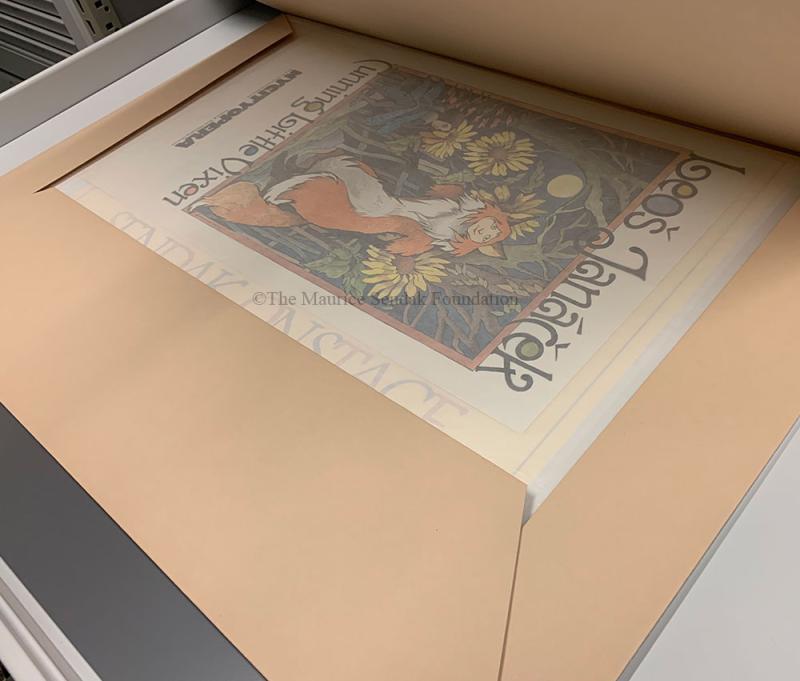
[Figure 8]
Interior of a flat-object housing enclosure in an oversized flat file drawer. Visible inside this enclosure is the poster for The Cunning Little Vixen, New York City Opera, 1981. 24 x 14 inches. The Morgan Library & Museum, Bequest of Maurice Sendak, 2013. 2013.105:160. ©The Maurice Sendak Foundation.
The three-dimensional objects are a bit more challenging. The sizes of these objects vary, they nearly all have irregular contours, and objects belonging to the same diorama need to be kept together. This requires careful planning to fit everything into the designated box or drawer. To house the diorama of Max’s sea journey, four trays were constructed out of custom-cut pieces of archival corrugated board (figure 10) that were adhered together using a combination of archival hot glue and double-sided tape. Like the folders, each tray is labeled with a barcode. The trays are rigid to prevent flexing of the objects when lifted, and each object fits snugly without physical attachment to the tray, so it can be easily removed when needed. Additionally, in this example, small pieces of board were added in select locations to prevent shifting of the smaller figures and props. These smaller objects are free-standing within the diorama and have integral stands at the bottom that are folded back to hold the figure or prop upright. Sometimes these stands can be unfolded so they are flat for storage, like the one extending from the hull of Max’s ship (figure 11). While other times, the stands are fixed into place, increasing the volume needed to house the object. For instance, the volume created by the fixed stand of the Sea Monster necessitated a clever storage solution of positioning the figure face-down and creating cutouts in the trays stacked above it. (figure 12).
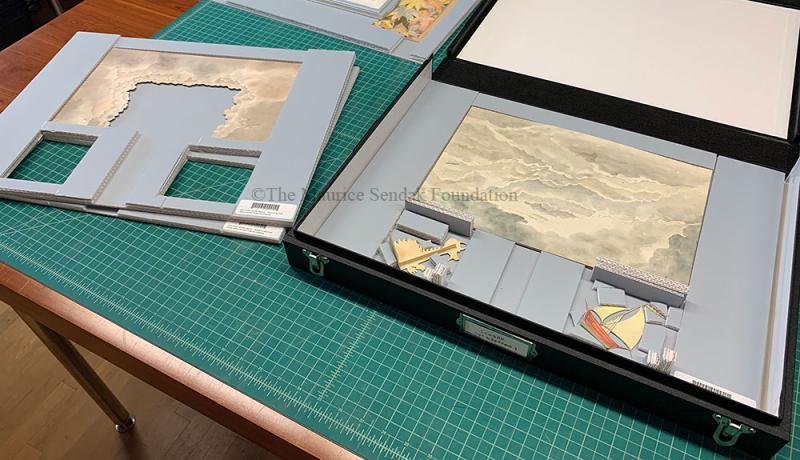
[Figure 10]
Storage solution for objects related to the diorama of Max’s sea journey (Where the Wild Things Are) in custom trays that fit inside a medium box. The Morgan Library & Museum, Bequest of Maurice Sendak, 2013. 2013.103:58e, 2013.103:60, 2013.103:63, and 2013.103:73. ©The Maurice Sendak Foundation.
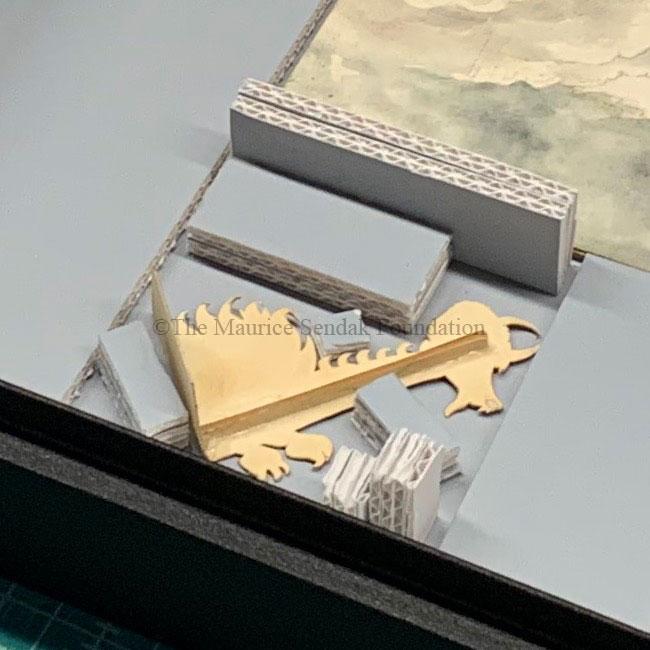
[Figure 12]
Face-down storage solution for Maurice Sendak, Sea monster model (Where the Wild Things Are), 1979–1983. Watercolor and pen and ink on paper mounted to paperboard, 3 1/2 × 2 3/4 x 1 1/2 inches. The Morgan Library & Museum, Bequest of Maurice Sendak, 2013. 2013.103:73. ©The Maurice Sendak Foundation.
The housing and storage of the Bequest of Maurice Sendak is no small undertaking and has been an ongoing project of the Thaw Conservation Center, spearheaded by the authors of this post and Frank Trujillo, Drue Heinz Book Conservator, that gained speed in 2017 with the preparation of Drawing the Curtain: Maurice Sendak’s Designs for Opera and Ballet, presented at the Morgan June 14 through October 6, 2019. Creating the custom enclosures requires thoughtful consideration of each and every object, which sets up numerous opportunities to be drawn into the fantastical world of Sendak. With the opening of a folder, we are transported into the middle of a wild rumpus and left mesmerized by Sendak’s amazing watercolor rendering of fur, feathers, and trees. A box of diorama parts calls to us to stand them upright and imagine ourselves on the stage. But we must resist the temptation and continue on with our progress, as many more objects await our attention.
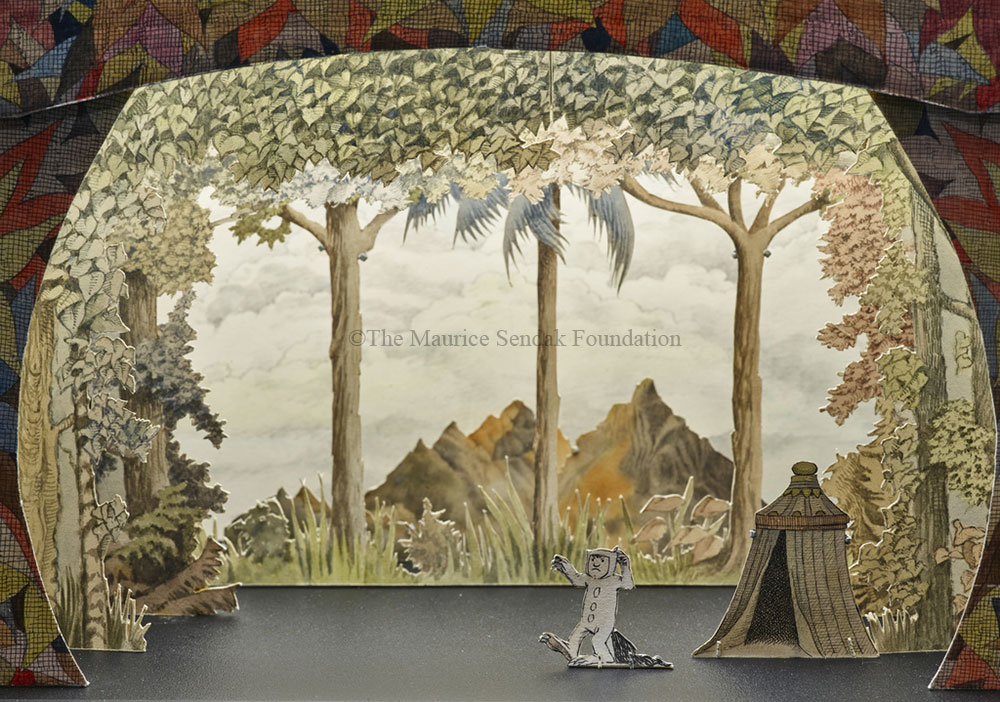
[Figure 13]
Diorama of Max in the forest (Where the Wild Things Are) as installed in Drawing the Curtain: Maurice Sendak’s Designs for Opera and Ballet, 2019. The Morgan Library & Museum, Bequest of Maurice Sendak, 2013. Reproductions of flower proscenium models (2013.103:69a-b and 2013.103:70), 2013.103:56c, 2013.103:57e–g, 2013.103:58d, 2013.103:59, 2013.103:65, 2013.103:66, and 2013.103:68. Artwork ©The Maurice Sendak Foundation. Digital Image ©The Morgan Library & Museum.
IMAGES
Janny Chiu, figures 1, 2, 5 ; Maria Fredericks, figures 7–12; Graham S. Haber, figures 3, 4, 6, 13.

